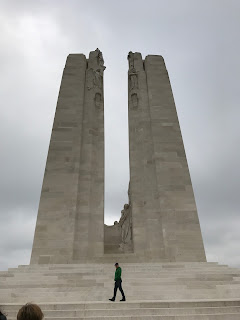One hundred years after World War I (1914-1918), the effects of the Battle of the Somme can still be seen in the landscape. As our coach drove through the beautiful French countryside of Arras we could soon see how it remains scarred by the large holes left from the munitions fired during the Battle of the Somme. All along the roadside are warning signs of possible unexploded artillery shells, serving as both a warning and a reminder of how war permanently alters our world. We first visited the preserved battle field of Vimy Ridge which is along the Western Front of World War I. This was a battle between the Canadian Corps and the German Army where the Canadians captured the ridge, an important strategical advance in the war. This massive memorial was created to commemorate Canadian soldiers who died in France and who have no known grave. This monument sits on 250 acres of preserved land and it is stationed with Canadian students offering historical background. It is truly stunning.
Vimy Ridge Memorial
Our next stop was the Beaumont-Hamel Trenches. Soldiers dug trenches to protect themselves from enemy fire and large mortar attacks. These trenches were winding and complicated networks where men spent most of the war. They were higher in the back and wound through the land on angles, this was so that an enemy could not open fire and shoot a whole "row" of men. Instead there were corners and blind spots. As we walked through a series of trenches it was like being beneath the surface, and one could see how the army on the defense could have the advantage in trench warfare.
The Trenches of Beaumont-Hamel
The Lochnagar Crater is an enormous hole created by eight miles of tunnels using mine warfare. The enormity of the crater shows the violence of war and the loss of human life. At 7:28 am on July 1st, 1916 in La Boisselle, near Albert, twenty-seven tons of high explosives were detonated in two chambers in the mines killing more than six thousand men (Lochnagarcrater.com).
We came to the bottom of the valley into a new country. It was a desert of broken chalk ditches, holes, craters, mounds, and ridges, dry and overgrown weeks and all interlaced with rusty strands of wire. There was not a house nor even a ruined wall left standing there might be a spike of brickwork where the church had been or not even that, merely mounds of rubble an discolored soil, the only landmark was a high rim of white chalk some one hundred fifty yards in diameter like the crater of a volcano. It began to dawn on me that this was La Boiselle, our objective. (Lt. Charles Carrington 1916)
The Lochnager Crater
In just the last year, one hundred and twenty soldiers' bodies were found in the area. Great care is taken in identifying and honoring the soldiers. Five Bavarian soldiers were recently discovered under The Old Blighty Tea Room in La Boisselle. Another, English soldier, Sgt. Blakey, was also found and identified when the road was widened. Sgt. Blakey left an infant son who fought in World War II who is still among the missing from that war.Dotted between these historic sites are homes and farms and the field where the Red Baron crashed on April 21,1918.



The different historic sites that you visited relating to World War I were very interesting to me. I have always been interested in the World Wars; I think it's important to study giant travesties like World War I and II in order to prevent similar events from occurring. Because of this, I found this post on the sites you visited very interesting. I think the part that struck me most was that there were college students stationed at the Vimy Ridge Memorial to provide more information on the historical context of the landmark. I think that's a very unique feature and I'm sure it brought a whole new dimension to the experience. Thank you for sharing.
ReplyDeleteWow, thanks a lot for this very informative post. I have never even heard of any of these places. It's crazy how little we learn about the history of other countries. Do you happen to know who fought in the Battle of The Somme? I can't believe they still have warning signs about the unexploded artillery shells. Like you said it definitely reminds us that the affects of war stay fresh long after the fighting is done. The trenches must have been really cool to see in person. The crater you described is so interesting, I can't believe I had never heard of it before. I just can't picture an explosion killing off that many people in 1916. And the fact that they are still discovering bodies is so heart breaking.
ReplyDeleteThank you for sharing! I also invisioned tranches being straight, I would have known about the angles the soldiers created to keep themselves safe. I did not know much about this battle or area before! There is so much war history that in school I feel like we only learned the 'main points'. Thank you for including such fascinating facts and information!
ReplyDeleteThis was so interesting to read! It's so crazy to think that a battle that happened one hundred years ago is still affecting the landscape of an area today. I could not imagine the eery feeling of knowing there's a possibility of unexploded artillery shells in your vicinity. Another part of this post that I enjoyed was learning about the trenches. Something that I never knew was that the trenches were not in straight lines! Even though I have learned so much about them in high school, this was something that was never mentioned. It was also so interesting to see that they are still intact today after over one hundred years.
ReplyDelete